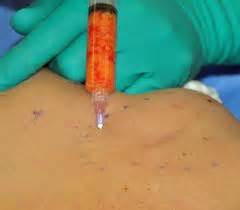
But variability of survival aside, when can a patient expect to see the final result from their fat grafting procedure? To understand the answer to this question, it is important to look at recent experimental studies and the dynamic nature of the zones of fat graft behavior after injection.
Immediately after fat grafting, almost all fat cells die unless they are located within a few hundred microns of the host tissues. This occurs in just days after the procedure. In this more central necrotic zone, fat and stem cells do not survive and become replaced by a scant amount of scar tissue. In an intermediate zone, fat cells still die but stem cells survive. Over the ensuing three months, adipose-derived stem cells are activated and convert to fat cells and/or replace dead fat cells. In the outer or more superficial zone right up against the recipient tissues, many cells do live including the donor site fat cells. Thus by three months after injection, the volume retention of the graft is usually apparent and stable.
The wild card in fat graft volume retention is what happens to the free lipid material after fat cells die. Some of the dead fat cells and their released pools of lipid do eventually get absorbed by macrophage cells. But this is dependent on the size of the lipid ‘pools’ or droplets. Generally they are completely absorbed by three month afterwards. In larger lipid droplets, this is a much slower process that can take up to a year to be absorbed. But if the pools of lipid are large enough, they may remain forever and become quietly encapsulated. (oil cysts) This is not the type of volume retention one wants as these cysts could become calcified or even serve as a nidus for a delayed inflammatory reaction. This speaks as to why it is important to filter, strain or otherwise remove as much of the free lipid as possible prior to injection.
In most patients, the expected final fat grafting result should be reserved to what is seen at three months after the procedure. At this point in time, the cellular component of the graft is stabilized and most of the free lipid has been absorbed/removed. Armed with this time period, patients should not get too anxious if the fat grafted area looks too big or distorted within the first month after surgery. Conversely they should not get too excited about the size of the fat graft if it looks like what they wanted in the first month either. Like all tissue transplantations, fat grafting is a dynamic process that takes months to play out.
As a final point about fat grafting retention, there is an urban legend that fat grafting is like planting seeds that take time to grow. This internet myth is propagated in that the transplanted fat will take off and get bigger months later as it grows. Much of this is seen in online buttock augmentation (Brazilian Butt Lift) discussions. There is no scientific basis for this phenomenon and thus it remains as an unsubstantiated theory. This does not mean that those fat cells that have survived or been replaced by stem cell activation can not acquire more intracellular lipids with weight gain years later. But this is a different type of growth which should not be confused with creating an initial fat grafting result.
Dr. Barry Eppley
Indianapolis, Indiana


